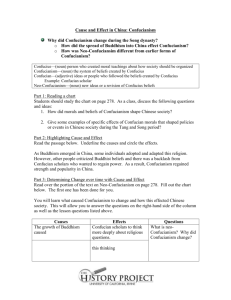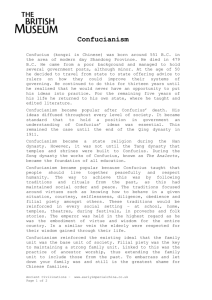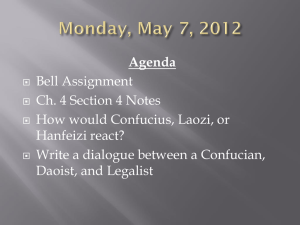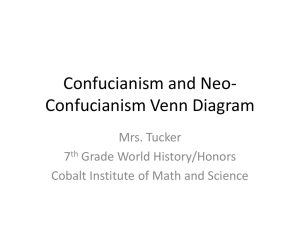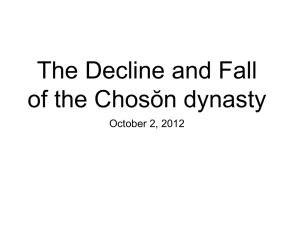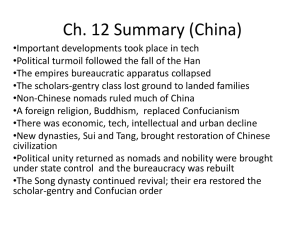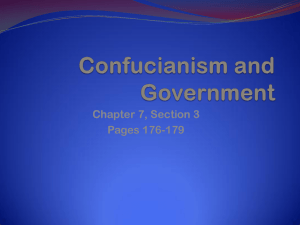Women and Confucianism in Choson Korea
advertisement
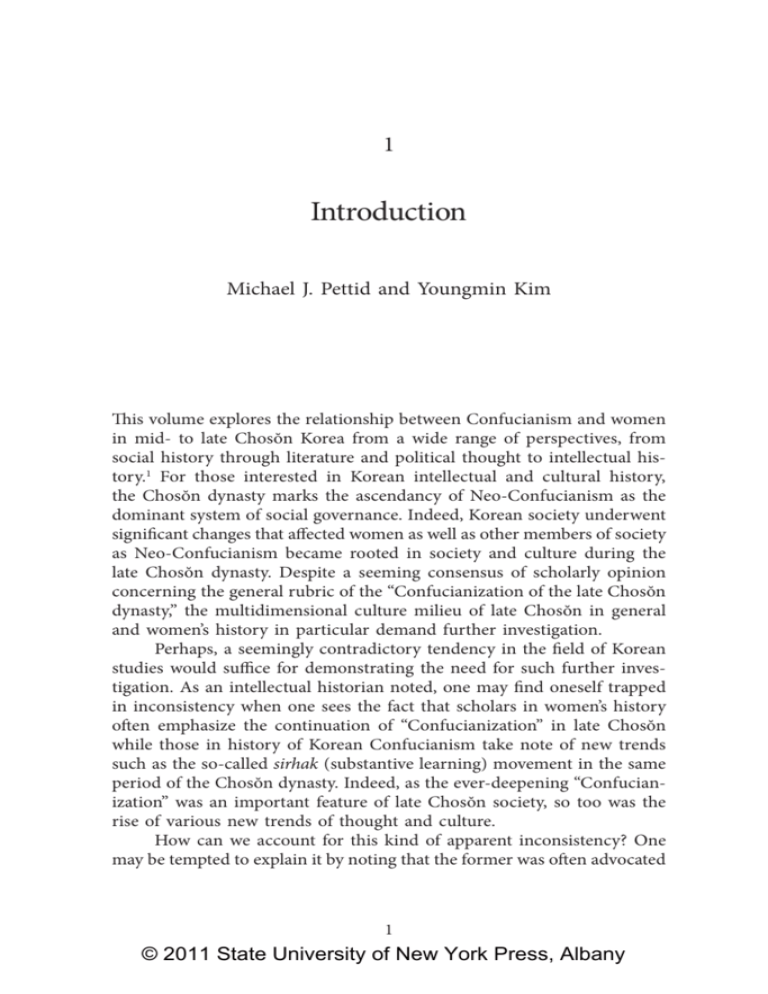
1 Introduction Michael J. Pettid and Youngmin Kim This volume explores the relationship between Confucianism and women in mid- to late Chosŏn Korea from a wide range of perspectives, from social history through literature and political thought to intellectual history.1 For those interested in Korean intellectual and cultural history, the Chosŏn dynasty marks the ascendancy of Neo‑Confucianism as the dominant system of social governance. Indeed, Korean society underwent significant changes that affected women as well as other members of society as Neo‑Confucianism became rooted in society and culture during the late Chosŏn dynasty. Despite a seeming consensus of scholarly opinion concerning the general rubric of the “Confucianization of the late Chosŏn dynasty,” the multidimensional culture milieu of late Chosŏn in general and women’s history in particular demand further investigation. Perhaps, a seemingly contradictory tendency in the field of Korean studies would suffice for demonstrating the need for such further investigation. As an intellectual historian noted, one may find oneself trapped in inconsistency when one sees the fact that scholars in women’s history often emphasize the continuation of “Confucianization” in late Chosŏn while those in history of Korean Confucianism take note of new trends such as the so‑called sirhak (substantive learning) movement in the same period of the Chosŏn dynasty. Indeed, as the ever‑deepening “Confucianization” was an important feature of late Chosŏn society, so too was the rise of various new trends of thought and culture. How can we account for this kind of apparent inconsistency? One may be tempted to explain it by noting that the former was often advocated 1 © 2011 State University of New York Press, Albany 2 Michael J. Pettid and Youngmin Kim by Western scholars and the latter by Korean scholars. Indeed, it seems that Western, mostly American, scholarship on the Chosŏn dynasty tends to emphasize the continuation of the “premodern” features of late Chosŏn culture while Korean scholarship focuses on “dynamic” aspects, which may be conducive to “modernity.” And yet, it should be also noted that the seeming inconsistency is most apparent, and it appears especially when we adopt a misleading vision of the historical reality, namely, a misleading view that portrays a unified and monolithic culture in late Chosŏn. Thus, rather than viewing the various conflicting elements of late Chosŏn culture as inconsistencies, the editors of this volume read them as signposts calling for the necessity of a more nuanced understanding of the multifaceted historical realities. Questioning what is oftentimes assumed about history is all the more crucial when considering the historic realities of women, who more often than not have been relegated to secondary status in historic examinations. Such a dismissive stance toward women and their place in historical times has consistently been proven incorrect as scholars cast off preconceived notions about what women might have been capable of achieving.2 It is the view of the editors of this volume that such a new scrutiny of women and Confucianism is sorely needed. To appreciate the complexity of the relationship between women and Confucianism in late Chosŏn, this volume is predicated on considering late Chosŏn culture on its own terms without assuming any unitary feature. As each essay in this volume, hopefully, shows, late Chosŏn culture in general and the relationship between women and Confucianism in particular, insofar as it was a unity at all, was a fragile and complex balance of various disparate and conflicting elements. To understand the relationship between Confucianism and women in late Chosŏn Korea more fully, it is necessary to recognize a number of different and conflicting strands in late Chosŏn culture, each of which imposed its own strains and tensions on the whole. How, then, can we appreciate such a complex historical reality? Of course, essential is historically sensitive analysis, which utilizes historical sources—oftentimes newly available—and thus empirically supports conclusions without resorting to a narrow, judgmental application of contemporary standards. In addition, it is absolutely imperative to recognize that neither “woman” nor “Confucianism” is a uniform category, as both terms have a tremendously complicated set of references. The idea that a unitary notion of Korean or Chosŏn women can be misleading is almost self‑evident when considering the fact that women, like other members of any given society, are likely to have different inter- © 2011 State University of New York Press, Albany Introduction 3 ests and preoccupations according to their stations within the society. Indeed, women are as divided by factors such as status, age, economic wherewithal, and geography as much as they are united by a shared gender. The worldview and aspirations of an upper status yangban woman living in the capital would have been quite different from those of a commoner status women living in a rural area. Even for women of the same status group in the same community there would have been major differences in worldview or goals depending upon the particulars of their personal situation. Finally, we can in no way assume that women’s lives in the early Chosŏn period were anything like those of women at the end of the dynasty. Accordingly, the notion of Chosŏn women contains tremendous internal diversity, the voices of many groups and individuals pursuing a wide range of goals. The notion of Confucianism is not any less complex. Confucianism has always meant different things to different thinkers and intellectuals. Even people who identify themselves as “Confucians” or who acknowledge that they share in the “Confucian” approach to such a degree that they see themselves as part of a sustained tradition, often disagree on who are the central figures within the tradition and who are not. Additionally, seeing Chosŏn Korea as a bastion of Neo‑Confucian orthodoxy, one even more rigidly following this school of thought than contemporary Chinese cultures, is also incorrect. As John Duncan has pointed out in his study of Confucianism in Chosŏn, such a viewpoint is closely linked to “the Hegelian‑inspired modern Western notion of the East as an unchanging traditional order.”3 Chosŏn society, like any other, was one with multiple influences and multiple responses to such influences. In fact, we might cite the multiplicity of worldviews, the syncretism of customs, and the constant change in social practices as being far more representative of what life in Chosŏn might have been rather than simply labeling it as a Confucian society. We should thus expect to find varied responses to Confucianism dependent upon numerous factors including social status, interest, time, place, and educational level. In this sense, the essays collected in this volume take up and expand upon a methodological stance adopted in the most recent studies on East Asian women.4 The authors do not have a shared focus on a specific group of women or a specific aspect of “Confucianism.” For a more nuanced investigation of the relationship between women and Confucianism in late Chosŏn Korea, the unitary notion of Chosŏn women is divided and subdivided into more specific and refined categories such as (no)bi, female philosophers, female literati, widows, and so on, until the category serves © 2011 State University of New York Press, Albany 4 Michael J. Pettid and Youngmin Kim the explanatory purposes more fully. Likewise, the authors were asked to define the term Confucianism or Neo-Confucianism within their essays, without assuming that there is a timeless unity in the Confucian tradition. In short, taking the relationship between women and Confucianism as its central focus, the contributors are very much in agreement concerning the need that umbrella categories such as “Chosŏn women” and “Confucianism” should be more carefully used to appreciate fully the complex, multiple layers of late Chosŏn culture. As a corollary, it is no part of the editors’ task here to support one and the same conclusion or blanket statements about late Chosŏn culture. At the same time, while the authors of this volume bring so many issues to our attention, their tacit acknowledgment of the validity of the subject on which we are writing in this volume—Confucianism and women—implies that we all believe that there are relationships between the two, and that those relationships are complex. Taken together, the essays in this volume hope to not only help us restore the tremendous internal diversity of late Chosŏn women’s history, but also enhance our ability to appreciate what Confucianism meant to various populations in Chosŏn society. Thematic Considerations and Boundaries The editors of this volume have sought to establish a new paradigm for understanding the diverse ways that women interacted with Confucianism from the mid- to late Chosŏn period. In order to understand the diversity of women’s lives in this period, acknowledging the complexity of the intellectual tradition of Confucianism and the heterogeneity of the lives of women must be a first step. Then, by building upon and expanding the parameters established by recent scholarship,5 it is our collective hope that throwaway generalizations of Chosŏn period women seen in phrases such as “Confucian oppression of women” and “the Confucian victimization of women” will be replaced with more complete understandings of how women actually lived in this period. Without doubt, Confucianism was the most important social system and nearly all people of late Chosŏn— regardless of gender, social status, economic means, or geographical location—followed these norms in at least part of their lives.6 Nonetheless, we must acknowledge that other belief systems—particularly Buddhism and shamanism—continued to play major roles in the lives of the people in general.7 Accordingly, the multidimensional nature of Chosŏn should be recognized and, moreover, we should allow for the possibility that the © 2011 State University of New York Press, Albany Introduction 5 people were able to conduct a significant part of their lives in realms not controlled by Confucian dictates. Yet, crucial to this volume is how women actually engaged Confucianism and how they were able to negotiate a means to fully live their lives. The image of the ideal Confucian woman—say for example that of Sin Saimdang (1504–1551) the mother of the famous Confucianist Yi I (1536–1584) whose image was largely fashioned by disciples of her son—is not a realistic or accurate standard for measuring women of this period. Such an image is one‑sided, particularly since it is not the voice of the actor we hear, but rather those attempting to shape the actor. A far more relevant image might be that of Lady Chang of Andong examined in this volume. Here we can understand the actions and motivations of the actor in her own words and deeds. In this same light, the contributions in this volume seek to give fuller and more accurate understandings of women in the mid- to late Chosŏn period. Given the vast period encompassed by the Chosŏn dynasty, we acknowledge that it is not possible to cover women’s lives of the period from start to finish. Rather, we have limited our focus to the late Chosŏn period—that is, the Chosŏn from the late seventeenth century forward— with the single exception of the chapter by Lee SoonGu on the rights of the eldest daughter‑in‑law (ch’ongbu) in the mid‑sixteenth century. This slight expansion of chronological bounds allows a clear demonstration of the ongoing settlement of Confucian norms in the legal and social systems of Chosŏn. Specifically, we can note the highly contested dissidence between long‑standing customs of Korean polities and the wishes of some ruling elites to push Chosŏn society toward a society based on strict understandings of propriety as outlined in Confucian teachings. While these battles were waged on many fronts throughout the Chosŏn, this particular instance reveals both attempts to preserve Korean custom and move to the model for the lineage principle (chongppŏp) of Confucianism. Important in this study is that we can definitively state that the differences between an ideological system of China and the native practices of Korea were numerous and that attempting to change customs was not a simple process. The points of contention are markers of the gap between what can be called “native” Korean practices and those imported from China in the form of Neo‑Confucian practices. Such markers are certainly crucial starting points for recognizing what the shape of Korean society might have been in times before Confucianism became the hegemonic social system. Thematically, the authors in this volume have brought several highly important topics forward. First among these is how women genuinely lived © 2011 State University of New York Press, Albany 6 Michael J. Pettid and Youngmin Kim within the Confucian social system. While this seems a very obvious consideration, it is nonetheless an aspect that has not been adequately addressed in studies of women in the late Chosŏn period, which largely focus on women of the uppermost status groups. One reason for this neglect is that women’s voices are oftentimes difficult to find in the official documents and literary records of Chosŏn, and this is all the more true for women of lower status groups. Yet, as the chapters in this volume will bring to light, these voices are indeed able to be heard if we search deep enough. The idea of living within the Confucian system was not really one that most women had to contemplate deeply. After all, it was a pervasive system and the government of Chosŏn made concerted and ongoing efforts to see this system imposed on nearly every aspect of society. For women, and in actuality all people, it was a matter of how to best live within this system. As long‑standing rights and freedoms slowly regressed over the first three centuries of Chosŏn, women were able to negotiate spaces where various rights could be maintained. As the authors in this collection demonstrate, such spaces were solidified by working within the Confucian legal system and also expanded through education. Far from passive bystanders, we see that women in this period were active participants in defining how Confucianism would unfold in reality. Perhaps one of the strongest themes that this volume has brought forward is that of the strategies that women employed for overcoming the various limitations imposed upon them by the Confucian social system. Whether or not such attempts to subvert the Confucian system were intentional, women did use various strategies to create more comfortable spaces for their lives and for exercising autonomy in select domains. Such comfort could be in the form of economic or status rights, or simply being able to better grasp the teachings of Confucianism. Certainly we can see examples of women using Confucianism to achieve various cultural ideals—a prime case is that detailed by Youngmin Kim in his chapter on the lives of two female Confucian philosophers. Thus, much like women of any period or place in history, the editors hold that the women of Chosŏn were more than capable of finding the best means to live within the restraints—real or imagined—that might have been present in the late Chosŏn period. The authors in this volume have brought to light the varied ways that women lived under the Confucian social system. Whether this was realized in retaining legal rights in the face of the continuous push to create a patriarchal frame by ruling elites or in simply pursuing their own best interests in remarriage, the volume attempts to focus on the very diverseness of women’s lives. Similar to the diverse understandings © 2011 State University of New York Press, Albany Introduction 7 of Confucianism in Chosŏn, we have sought to bring to light the diversity of women in Chosŏn to this volume. Rather than focusing only on upper status women, the authors in this collection have examined the lives of women ranging from members of the yangban status to those of slave status. Chosŏn was a complex society where status would either afford great privileges or enact significant limitations. However, along with rights came obligations and perhaps less space to act in a manner contrary to social norms. Organization of the Volume This volume begins with an essay written by Youngmin Kim that demonstrates how very different understandings of Confucianism could be based upon time and environment. Kim’s chapter exposes the complexities inherent to Confucianism and the danger of oversimplifying this worldview. He examines two narratives: Yingying chuan [The tale of Yingying] of Tang China and Ch’unhyang‑jŏn [The tale of Ch’unhyang] of the Chosŏn dynasty to bring into sharp relief the different manifestations of Confucianism and the manifold means that this could be employed by women in their lives. This essay adds to the present scholarship that seeks to break away from monolithic understandings of Confucianism that fail to appreciate the historical complexity of the relationship between women and Confucianism. The next chapter is an examination of the life of Lady Chang of Andong by Lee SoonGu. This description of a yangban woman who embraced Confucianism as a means to find personal agency reveals how women were able to find self‑fulfillment and empowerment within the dominant ideology of the mid- to late Chosŏn period. Somewhat like the female philosophers in Youngmin Kim’s chapter described below, Lady Chang was able to understand and manipulate Confucian ideals in her life and find a space in which she excelled and was acknowledged highly by society. As the chapter well demonstrates, a woman of this period was as able to reach sagehood as a man through the mastery of Confucian virtue as illustrated in the life of Lady Chang. Michael Pettid’s chapter focuses on the general aim of educational works in the late Chosŏn period for women, and what these works reveal about the social expectations that elite society held for women. This chapter highlights the difference in government and private educational works for women, and also how education for women became increasingly broad as the dynasty moved toward the nineteenth century. We further see that © 2011 State University of New York Press, Albany 8 Michael J. Pettid and Youngmin Kim Konbŏm [Rules for women], a text thought to be authored by a woman, attempted to provide its readers with a tool for engaging Confucianism as a means of gaining a space for agency. This again allows cognition that women of the late Chosŏn understood the necessity of engaging Confucian ideals as a means of bettering their lives and for self‑realization. Moreover, such a text further demonstrates that women were far from passive victims of the Confucian social system, but rather active participants in shaping the realities of this ideology. Also demonstrating that women were not helpless victims or bystanders is the chapter by Youngmin Kim on two female intellectuals of late Chosŏn, Im Yunjidang (1721–1793) and Kang Chŏngildang (1772–1832). This chapter reveals that while Confucianism did limit women to certain roles and restrict them from aspects of officialdom, these two Confucian philosophers still understood that they were as able as men to find perfection within their lives. It was the Confucian ideal of “universal sagehood” that provided a basis for these women to justify their own study of Confucianism. Kim shows this to be an outcome of their desire for self‑fulfillment at a time when the only real option available to them was Confucianism. Rather than shrinking from Confucianism, these two women found empowerment in its ideals. Our single mid‑Chosŏn piece is the chapter by Lee SoonGu on the rights of the eldest daughter‑in‑law (ch’ongbu) in terms of designating a legal heir in the event of her husband dying before the birth of a son. Here we are treated to a glimpse of women struggling within the bounds of the Confucian‑based legal system to retain their status and power within a family. The right to name an heir was extremely important to this end, and Lee’s chapter shows that women held fast to this right and sought to adopt heirs from distant collateral lineages that preserved their positions of power. Moreover, as mentioned above, this chapter allows cognition of the complexities of introducing a foreign ideological system to Chosŏn and the conflicts that resulted from the clash with native custom. Moving away from focus on solely upper status women is the chapter by Jung Ji‑Young on the position and agency of widows in late Chosŏn. By examining census data in the Tansŏng‑hyŏn hojŏk taejang [The household register for Tansŏng‑hyŏn], this chapter examines the efforts of widows to maintain their rights as householder in the face of legislation designed to award the eldest son such rights upon the death of his father. As Jung demonstrates, widows resisted this change through a variety of responses and sought to preserve their social position as householder. Moreover, we can clearly see that responses to inroads by patriarchal norms such as the right of householder becoming exclusively male and prohibition on © 2011 State University of New York Press, Albany Introduction 9 remarriage by widows varied by social status. Thus, it is clear that even in the late Chosŏn there remained much resistance to seceding heretofore important rights held by women. Like the essays above, this examination allows a realization that women were not simply the victims of Confucian legislation, but rather used various strategies to retain their rights. Our final chapter is by Milan Hejtmanek and examines status changes among female slaves. Slavery, as well argued by Hejtmanek, was a decidedly un‑Confucian practice that nonetheless thrived in Chosŏn Korea due to a perceived economic necessity by the ruling elites. By using official and private accounts of the time, this chapter reveals that some slaves employed strategies of fleeing in order to claim freeborn status; of course, this was a matter that was contested by former owners if the slave was captured. We also see in this chapter the fluidity of slave status and how women could move in and out of slave status. The editors of this volume would like to acknowledge the generous support of the International Center for Korean Studies (ICKS). The project was conceived and initiated by the publication project of ICKS and would not have otherwise been possible without their support. The ICKS also assisted us with further honing the project by reviewing a first draft of the manuscript and adding valuable input at that time. We also owe thanks to the translators for this volume. Translations of chapters 3 and 6 were done by Kil Cha of Binghamton University; the translation of the first portions of chapter 7 was done by Adam Bohnet and the remainder by Kil Cha. Some of the papers in this volume were initially presented at the 2005 Association for Asian Studies annual conference held in Chicago. The unusually large attendance for our panel and the insightful comments by audience members convinced us that the time was ripe for a serious assessment of this issue. Further, some of the papers were also presented in Korea at Women’s World 2005, 9th International Interdisciplinary Congress on Women. Again, this panel was treated to a large audience and excellent commentary from our colleagues in Korea. We sincerely hope that this volume will enable a continuation of the scholarly exchange and growth began at those times and help foster future studies. Notes 1. Throughout this volume we have used the McCune‑Reischauer system for transliterating Korean words into English except in cases where there is an accepted conventional spelling in the West (e.g., Seoul) or for personal names when there is an individual preference. © 2011 State University of New York Press, Albany 10 Michael J. Pettid and Youngmin Kim 2. Such a position as this is certainly demonstrated in various aspects of historical studies on Chosŏn. For example, we can cite the recent acknowledgment in Korean literary studies that a whole category of novels once attributed to males is now widely recognized as being the productions of women. See Chŏng Ch’urhŏn, Kojŏn sosŏl ŭi kudu wa sigak [Structure and view in classical novel history] (Seoul: Somyŏng ch’ulp’an, 2003), 189–215. In terms of political and social agency, a recent study by Yun Chŏngnan demonstrates that the queens of the Chosŏn dynasty wielded significant influence at various points in time. See Chosŏn wangbi obaek nyŏn sa [A five hundred year history of the queens of Chosŏn] (Seoul: Iga ch’ulp’ansa, 2008). 3. John B. Duncan, “Examinations and Orthodoxy in Chosŏn Dynasty Korea,” in Rethinking Confucianism: Past and Present in China, Japan, Korea, and Vietnam, ed. Benjamin A Elman, John B. Duncan, and Herman Ooms (Los Angeles: UCLA Asian Pacific Monograph Series, 2002), 66. 4. See, for example, Dorothy Ko, JaHyun Kim Haboush, and Joan R. ­Piggott eds. Women and Confucian Cultures in Premodern China, Korea, and Japan, (Berkeley: University of California Press, 2003). 5. Particularly Ko et al., eds. Women and Confucian Cultures; Chenyang Li, ed., The Sage and the Second Sex: Confucianism, Ethics, and Gender (Chicago: Open Court, 2000); Patricia Ebrey, The Inner Quarters: Marriage and the Lives of Chinese Women in the Sung Period (Berkeley: University of California Press, 1993). 6. The official‑private characterization of Chosŏn society is quite apt in this point. We can certainly note the flourishing of shamanic and Buddhist customs in some aspects of society while also acknowledging the hegemony of Confucianism in other areas. Much like Mikhail Bakhtin described for Western Europe of a similar period, the public‑private distinctions of Chosŏn allowed for varying spheres where individuals could use cultures appropriate for their needs. See Mikhail Bakhtin, Rabelais and His World, trans. Hélène Iswolsky (Bloomington: Indiana University Press, 1984). 7. There is copious scholarship supporting such a position. Two of the best works in English are found in JaHyun Kim Haboush and Martina Deuchler, eds., Culture and the State in Late Chosŏn Korea (Cambridge, MA: Harvard‑Hallym Series on Korean Studies, 1999). For Buddhism see Robert E. Buswell Jr, “Buddhism under Confucian Domination: The Synthetic Vision of Sŏsan Hyujŏng”; and for shamanism see Boudewijn Walraven, “Popular Religion in a Confucianized Society.” © 2011 State University of New York Press, Albany
